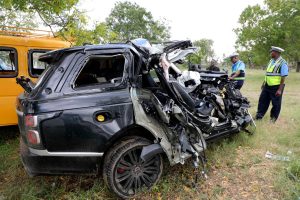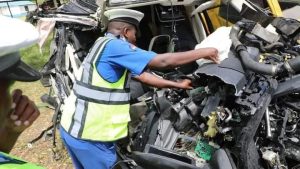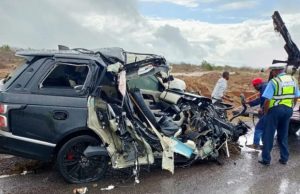In the early hours of August 27, 2024, a devastating accident in the Mariakani area of Kilifi County, Kenya, claimed two lives and left three others severely injured. The collision between a Range Rover and a canter truck has sent shockwaves through the local community, highlighting the persistent dangers on Kenyan roads.
Road accidents have long been a concern in the country, but this particular incident has drawn significant attention due to the tragic loss of life and the circumstances surrounding the crash.
This article delves into the details of the accident, exploring the factors that contributed to the tragedy, the immediate aftermath, and the broader implications for road safety in Kilifi County and Kenya as a whole. Through a comprehensive analysis, we aim to provide a thorough understanding of the events leading up to the crash and the lessons that can be learned to prevent similar incidents in the future.
Tragedy Strikes Kilifi As Two Die In A Range Rover Accident And Canter Crash
The incident occurred on the Mombasa-Nairobi highway, a stretch of road notorious for accidents due to heavy traffic, poor driving habits, and challenging road conditions. The collision took place at around 7 a.m., when a Range Rover, driven by 37-year-old Jamal Mubarak, collided head-on with a canter truck.
Mubarak, who was reportedly speeding, was attempting to overtake another vehicle when the collision occurred. The impact was so severe that both Mubarak and his female passenger died instantly, while the three occupants of the canter truck sustained serious injuries.
The Collision: What Happened?
On that fateful morning, Jamal Mubarak, a well-known motor vehicle dealer based in Mombasa, was driving a Range Rover from Mombasa towards Nairobi. According to eyewitness reports and a police statement, Mubarak was driving at a high speed and attempted to overtake another vehicle near the Maji Ya Chumvi area.
However, he miscalculated the maneuver and collided head-on with an oncoming canter truck. The force of the collision was catastrophic, leading to the immediate deaths of Mubarak and his female passenger.
The canter truck, which was heading towards Mombasa, was carrying goods and had three occupants. The impact left the truck severely damaged, and all three individuals inside were critically injured. They were rushed to Mariakani Sub-County Hospital for emergency treatment. The condition of the injured remains serious, but they are currently receiving medical care.
The accident has raised several questions about the state of road safety in Kilifi County and the factors that contributed to this tragic event. Was it merely a case of reckless driving, or were there other underlying issues at play? These are questions that the ongoing investigation seeks to answer.
Factors Leading to the Tragedy
1. Speeding
Speeding is one of the leading causes of road accidents globally, and Kenya is no exception. In this case, it is evident that Mubarak’s excessive speed was a significant contributing factor.  High speeds reduce the driver’s ability to react to sudden changes on the road, increasing the likelihood of an accident. The speed at which Mubarak was driving made it impossible for him to avoid the oncoming truck once he realized his mistake.
High speeds reduce the driver’s ability to react to sudden changes on the road, increasing the likelihood of an accident. The speed at which Mubarak was driving made it impossible for him to avoid the oncoming truck once he realized his mistake.
2. Improper Overtaking
Overtaking on highways can be dangerous, especially when not done with caution. The stretch of road where the accident occurred is known for its heavy traffic, and overtaking requires careful judgment. Unfortunately, Mubarak’s attempt to overtake another vehicle proved fatal. His miscalculation resulted in a head-on collision with the oncoming canter truck.
3. Road Conditions
The condition of the Mombasa-Nairobi highway has often been cited as a contributing factor to accidents. While the road is one of the busiest in the country, it is also prone to congestion and has several sections that are in need of repair. These conditions can make driving more hazardous, particularly for those unfamiliar with the road or driving at high speeds.
4. Driver Fatigue
Although not confirmed in this case, driver fatigue is a common issue on long drives, especially on busy highways. Fatigue can impair a driver’s judgment and reaction times, making it more difficult to respond to sudden situations on the road. Whether fatigue played a role in this accident is yet to be determined, but it remains a factor worth considering in such cases.
5. Lack of Road Safety Awareness
Despite numerous campaigns, there is still a lack of road safety awareness among many drivers in Kenya. The importance of adhering to speed limits, proper overtaking procedures, and other road safety measures cannot be overstated. This tragic accident underscores the need for continuous education and enforcement of road safety rules.
Immediate Aftermath
In the immediate aftermath of the collision, emergency services were quickly dispatched to the scene. The wreckage of both vehicles was severe, with the Range Rover and the canter truck both heavily damaged. The bodies of Mubarak and his passenger were retrieved from the vehicle and transported to the Coast General Hospital Mortuary in Mombasa.
The three injured individuals from the canter truck were rushed to Mariakani Sub-County Hospital, where they were admitted for emergency treatment. The exact nature of their injuries has not been disclosed, but their condition was described as critical. The hospital staff worked tirelessly to stabilize them, and they continue to receive care as they recover from the trauma of the accident.
The police cordoned off the area and began an investigation into the circumstances surrounding the crash. Preliminary reports pointed to speeding and improper overtaking as the primary causes, but the investigation aims to uncover all contributing factors, including the possibility of mechanical failure or other external influences.
Community Response and Impact
The Mariakani area, like many parts of Kilifi County, is a close-knit community where news travels fast. The tragic accident quickly became the talk of the town, with residents expressing shock and sorrow at the loss of life. Many people knew Mubarak personally, either through his business dealings or as a fellow resident of the region. His sudden death, along with that of his passenger, has left a void in the community.
The accident has also reignited discussions about road safety in Kilifi County. Residents have long voiced concerns about the dangers of the Mombasa-Nairobi highway, particularly the stretch where the accident occurred. The road is a vital artery for transportation between Kenya’s two largest cities, but its heavy traffic and challenging conditions have made it a hotspot for accidents.
Local leaders and community members have called for immediate action to address the safety concerns on this highway. Suggestions include better road maintenance, increased traffic enforcement, and more public awareness campaigns on road safety. There is a growing consensus that something must be done to prevent future tragedies like the one that claimed the lives of Mubarak and his passenger.
Ongoing Investigation
The investigation into the accident is being led by the Kilifi County Police Department, with assistance from traffic safety experts. The goal is to determine the exact cause of the collision and whether any additional factors contributed to the tragedy.
As part of the investigation, both vehicles involved in the crash have been impounded for a thorough examination. Investigators will be looking at several aspects, including the condition of the vehicles, the speed at which they were traveling, and any potential mechanical failures. They will also be reviewing traffic camera footage and speaking with witnesses to piece together the events leading up to the collision.
The results of the investigation will be crucial in determining whether any charges will be filed. In cases where reckless driving or negligence is proven, legal action may be taken against those responsible. Additionally, the families of the victims may pursue civil lawsuits for damages.
Road Safety in Kilifi County: A Growing Concern
The tragic accident in Mariakani is not an isolated incident. Road safety has been a growing concern in Kilifi County and across Kenya. The Mombasa-Nairobi highway, in particular, has seen a significant number of accidents in recent years, many of them fatal.
Several factors contribute to the high rate of accidents on this highway. In addition to speeding and reckless driving, the road’s infrastructure is often cited as a problem. Potholes, poorly marked lanes, and inadequate signage make driving on this road hazardous, especially for those unfamiliar with the area.
Furthermore, the highway is heavily used by both passenger vehicles and commercial trucks, leading to congestion and frequent traffic jams. The mix of different types of vehicles, combined with the challenging road conditions, increases the risk of accidents.
The government has taken steps to address these issues, including road repairs and increased traffic enforcement. However, these measures have not been enough to significantly reduce the number of accidents. There is a growing call for more comprehensive solutions, including better road design, stricter enforcement of traffic laws, and improved driver education.
The Human Cost of Road Accidents
While the focus is often on the numbers – how many accidents, how many deaths – it is important to remember the human cost of road accidents. Each statistic represents a life lost, a family devastated, and a community in mourning.
The deaths of Mubarak and his passenger are a stark reminder of the fragility of life and the consequences of unsafe driving practices. For the families of the victims, the pain is immeasurable. They have lost loved ones suddenly and tragically, with little warning and no chance to say goodbye.
For those who survived the crash, the road to recovery will be long and difficult. Physical injuries are often accompanied by emotional and psychological trauma, which can take years to heal. The impact of a serious accident is felt not only by the victims but also by their families, friends, and communities.
Preventing Future Tragedies: What Can Be Done?
In the wake of this tragic accident, there is a pressing need to address the underlying issues that contribute to road accidents in Kilifi County and across Kenya. Preventing future tragedies will require a multi-faceted approach that involves government action, community involvement, and individual responsibility.
1. Improved Road Infrastructure
One of the most effective ways to reduce accidents is to improve road infrastructure. This includes repairing potholes, clearly marking lanes, installing proper signage, and ensuring that roads are well-lit. These measures can make a significant difference in preventing accidents, particularly in high-traffic areas like the Mombasa-Nairobi highway.
2. Stricter Traffic Enforcement
Enforcing traffic laws is essential in promoting safe driving behavior. Speeding, reckless driving, and other dangerous behaviors should be met with strict penalties. Increased police presence on highways and the use of traffic cameras can help deter drivers from engaging in unsafe practices.
3. Public Awareness Campaigns
Education plays a crucial role in improving road safety. Public awareness campaigns can help inform drivers about the dangers of speeding, the importance of wearing seatbelts, and other key safety practices. These campaigns should be ongoing and targeted at both new and experienced drivers.
4. Driver Training and Education
Ensuring that drivers are properly trained and educated is another important step in preventing accidents. Driving schools should emphasize the importance of road safety and proper driving techniques. Regular refresher courses for experienced drivers can also help reinforce safe driving practices.
5. Community Involvement
Communities can play a vital role in promoting road safety. Local leaders, schools, and community organizations can work together to raise awareness about the importance of safe driving. Community-driven initiatives, such as neighborhood watch programs, can also help monitor and report unsafe driving behaviors.
6. Government Initiatives
The government has a responsibility to take the lead in improving road safety. This includes investing in infrastructure, enforcing traffic laws, and supporting public awareness campaigns. Collaboration with international organizations and NGOs can also help bring in expertise and resources to address road safety challenges.
Tragedy Strikes Kilifi As Two Die In A Range Rover Accident And Canter Crash FAQs
- What was the cause of the accident in Kilifi?
- The accident was caused by speeding and improper overtaking by the driver of the Range Rover, leading to a head-on collision with a canter truck.
- Who were the victims in the Kilifi accident?
- The victims were 37-year-old Jamal Mubarak, the driver of the Range Rover, and his unidentified female passenger.
- What were the injuries sustained in the Kilifi accident?
- The three occupants of the canter truck sustained serious injuries and were admitted to Mariakani Sub-County Hospital for treatment.
- How did the community respond to the Kilifi accident?
- The community expressed shock and sorrow, with many residents calling for increased road safety measures on the Mombasa-Nairobi highway.
- What is being done to prevent future accidents on the Mombasa-Nairobi highway?
- Measures include road repairs, increased traffic enforcement, and public awareness campaigns on road safety.
- What role did speeding play in the Kilifi accident?
- Speeding was a major factor in the accident, as it reduced the driver’s ability to react to the oncoming truck during the overtaking maneuver.
- What are the common causes of road accidents in Kilifi County?
- Common causes include speeding, reckless driving, poor road conditions, and driver fatigue.
- What steps can drivers take to stay safe on the road?
- Drivers should adhere to speed limits, avoid reckless driving, ensure their vehicles are in good condition, and stay alert while driving.
- How can road infrastructure be improved to prevent accidents?
- Improvements can include repairing potholes, marking lanes clearly, installing proper signage, and ensuring roads are well-lit.
- What is the government doing to improve road safety in Kenya?
- The government is investing in infrastructure, enforcing traffic laws, and supporting public awareness campaigns to improve road safety.
Conclusion
The tragic accident in Kilifi serves as a painful reminder of the dangers that lurk on our roads. The loss of life and the injuries sustained are a testament to the consequences of reckless driving and the need for greater attention to road safety.
As a community, as a nation, we must come together to address the factors that contribute to such tragedies. Improved infrastructure, stricter enforcement of traffic laws, and continuous education on road safety are essential steps toward preventing future accidents .
.
But beyond the policies and measures, it is the responsibility of each individual driver to prioritize safety. Every time we get behind the wheel, we make choices that can have life-altering consequences. Let this tragedy be a call to action for all of us to drive more carefully, to respect the rules of the road, and to value the lives of those around us.
In memory of those lost, and in hope for a safer future, let us all commit to making our roads safer for everyone. Take action today: drive safely, support road safety initiatives, and spread awareness to save lives.
Recent Posts
Platinum credit cards in the UK are designed for people who want premium benefits, flexibility, and financial power in one product. They typically combine rewards, travel protection, lifestyle perks,...
The Gold Card is designed to offer a premium pathway to residency, mobility, and economic opportunity through verified financial contribution. It represents a shift toward value-based access rather...